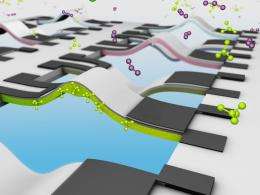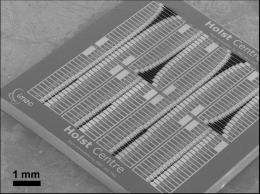New gas sensor chip paves the way to autonomous e-nose

Imec and Holst Centre researchers have developed very sensitive integrated sensing elements for gas detection. The polymer-coated microbridges in high-density arrays can detect ppm-level concentrations of vapors using on-chip integrated read-out techniques. The demonstrated technology is very suitable for miniaturization of electronic nose devices thanks to the low power consumption (<1 µW/bridge) and small form factor.
Wireless sensor nodes that can chemically detect gaseous compounds are rapidly gaining interest from markets such as food monitoring, healthcare and safety. One of the main gas sensing approaches in uncontrolled environments is the identification of vapors (“smells”) using multiple sensing elements (“receptors”), in a system that is often referred to as an “electronic nose” or “e-nose”. An accurate e-nose requires small, integrated, low-power detectors with individually tuned chemical coatings. Current solutions, like chemi-resistors or quartz crystals are however not scalable or power-efficient enough to build low-power small form factor e-noses.
Imec and Holst Centre have developed a new generation of microbridges with embedded individual piezoelectric “shakers” in a high-density array with very high fabrication yield. The novel design allows for rapid coating of a range of absorbents on individual microbridges using commercial inkjet printing technology. The suspended structures vibrate individually, and changes in their modes of vibration (resonances) are monitored as an indication of vapor absorption in their coatings. Due to the very high length-to-thickness ratio of the microbridges, imec and Holst Centre’s novel gas sensor chip has a high sensitivity to low-concentration vapors. Moreover, by implementing integrated piezoelectric read-out schemes, ultra-low power operation could be demonstrated.

Current work is ongoing to integrate the structures with low-power analog read-out circuits and to demonstrate simultaneous measurements from multiple structures. This truly low-power miniaturized implementation of an e-nose technology can be used in current applications such as wine and cheese monitoring, but could in the future also help sniff-out human conditions such as asthma, lung cancer, and kidney diseases.
Source: IMEC




















